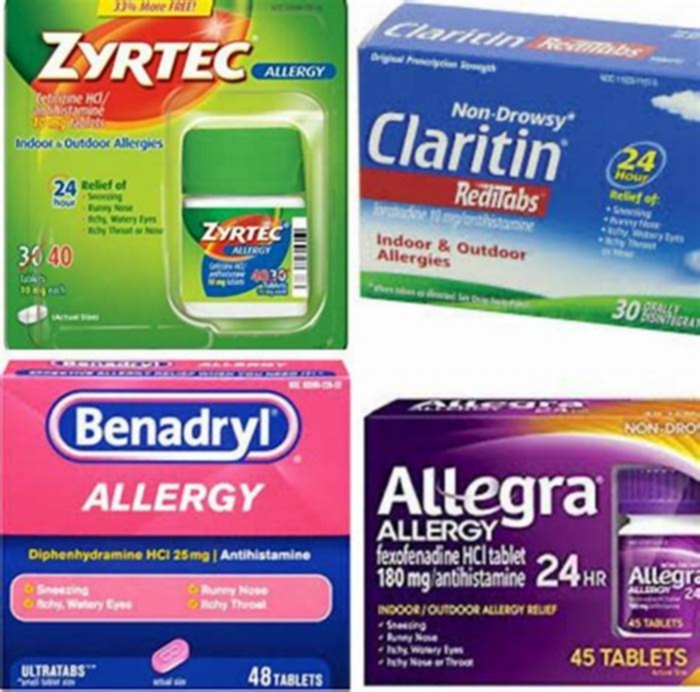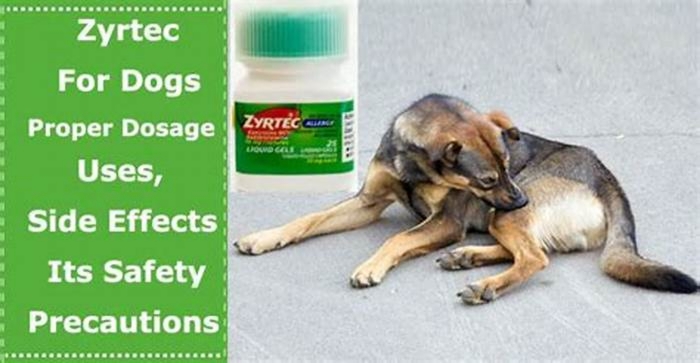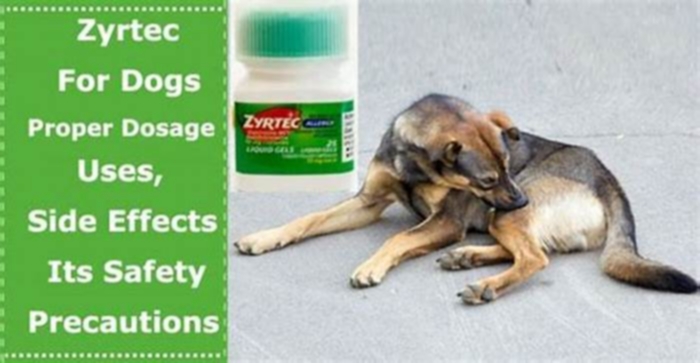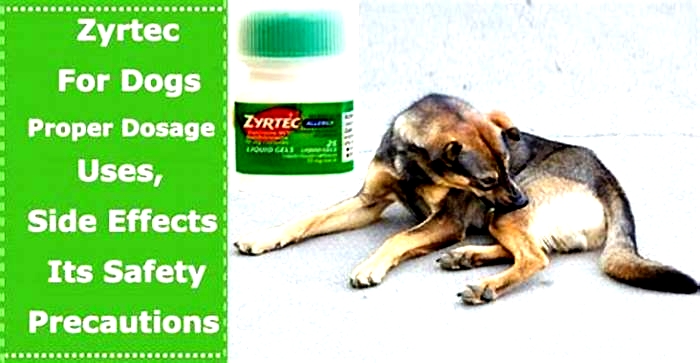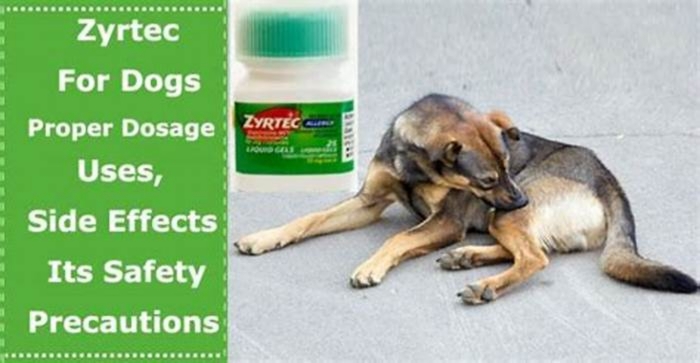Can I mix Benadryl and Zyrtec for my dog
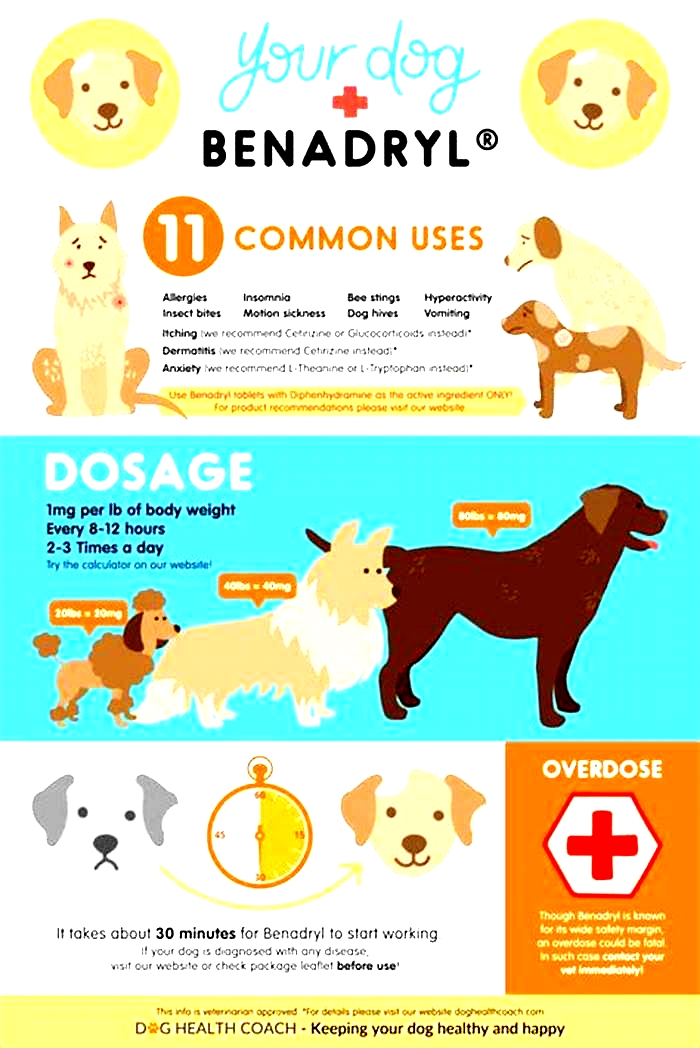
Can I Give My Dog Zyrtec and Benadryl?
Is your dog itching all over and scratching like mad? Are his eyes watery? Is he sneezing a lot?
Looks like your pet has an allergy, but what can you do to relieve his symptoms before you see a vet and get a clear diagnostic? Can you give your dog Benadryl or Zyrtec, drugs many people already have in their medicine cabinets?
Short answer yes, allergy drugs meant for humans are considered to be safe for pets, both dogs and cats. You need however to be very careful when you give Benadryl or Zyrtec to a dog. In this article well explain whats the proper dosage for dogs, well examine possible side effects and also have a look at the most common allergies in dogs.
Can I give my dog Benadryl and Zyrtec at the same time?
There are very little studies on the safety of combining two antihistaminic drugs, but, as a general rule, experts say you should not take Benadryl and Zyrtec at the same time, as this might lead to stronger side-effects. This advice refers to human consumption, but since youre using human drugs on your pet, the same applies to them.
If you feel one drug isnt working for your dog, best wait till the next day to offer him a different one.
Many pet owners wonder which of the two drugs is better, but that is impossible to answer. Each dog reacts differently to them so if you have any doubts you should ask your vet what they recommend.
How much Benadryl can I give my dog?
Benadryl is the brand name for diphenhydramine, which is an antihistamine used to treat allergies in both humans and dogs. For the time being, Benadryl is not FDA-approved for use in dogs, but experts consider its nevertheless safe.
Veterinarians have been using human antihistamines to treat dog allergies for years and have determined how much Bendaryl is safe to give to your suffering pet. It all depends on your dogs weight. According to the Merck Veterinary Manual, the recommended dosage for Benadryl is 2 4mg/ kg or 0.9 1.8 milligrams per pound.
If its the first time youre giving Benadryl to your dog, you should give him a low dose, in case he develops side effects (more on that later). For instance, if you have a small 10 lbs dog you should give him 10 mg of Benadryl, which represents 1 mg/ pound. Likewise, a 50 lbs dog should get 50 mg of Benadryl.
Examine the type of Benadryl you have in your cabinet, see how many milligrams there are in a tablet or liquid dose and do the math. If you have 25 mg tablets, a 50 lbs dog can safely have two of them, but for a small dog youll have to cut it in half. Liquid Benadryl might be easier to manage as you can measure how many drops your dog can have.
You can give Benadryl to your dog 2 or 3 times a day at regular intervals.
Even if youre not sure that your dog is indeed having an allergic reaction and not something else, you can give him some Benadryl and wait to see if theres any improvement.
If you dont see any improvement, you should take the dog to a vet as soon as possible as he might have other health issues.
What are the side effects of Benadryl in dogs?
First of all, you should avoid giving your dog Benadryl that might contain alcohol or decongestants. For instance, certain formulations like Benadryl Cough Syrup or Benadryl Liquid Elixir, might contain 5 14 % alcohol, which is toxic to dogs.
Obviously, a few drops wont harm your dog in any way, but if he suffers from seasonal allergies and requires long-term antihistamine treatment you shouldnt use a product that contains alcohol.
Tablets are usually safe as they do not contain alcohol at all.
Like all drugs, Benardyl can cause various side effects, such as:
- Drowsiness
- Increased heart beat
- Rapid breathing
- Inability to urinate
- Dry mouth
Some less common side effects are vomiting and diarrhea, or changes in your dogs appetite.
Keep in mind that this advice is intended for adult dogs. If you have a puppy, a pregnant or nursing dog its best to talk to a vet before administering Benadryl.
How much Zyrtec can I give to my dog?
Zyrtec is another popular type of antihistamine and its active ingredient, cetirizine, is also considered safe for dogs.
According to the same Merck Veterinary Manual, the recommended dosage is 1 mg/ kg. A 10 kg (22 lbs) dog should get 10 mg. S
ome Zyrtec adult formulations contain 10 mg tablets, so one should be enough for a 10 kg dog.
Zyrtec can be given no more than once or twice a day.
The same goes for Claritin, the brand name for another antihistamine in which the main ingredient is loratadine. Claritin can be given once or twice a day and the recommended dosage is 0.2 mg/pound.
Just as with Benadryl, both Zyrtec and Claritin can cause side effects such as dry mouth and stomach problems, and drowsiness, although to a lesser extent than Benadryl.
Never leave antihistamines within the dogs reach as he can easily chew the plastic container and overdose.. The most common signs of antihistamines overdose include dilated pupils, rapid heart rate and seizures. Take the dog to the vet right away.
What are the most common allergies in dogs?
Allergies start manifesting in dogs usually after they reach six months of age. The vast majority of dogs diagnosed with an allergy are young animals, aged one or two.
Around 10% of all dog allergies are food allergies, with the most common allergens in this category being beef, dairy products, wheat, egg, and various other types of meat. If your dog develops an allergic reaction after youve just changed their regular food, youll have to examine the ingredients on the label to see what might be causing the problem. Unfortunately, dogs can be allergic to more than one type of food so its going to be hard to determine what doesnt agree with him.
At the same time, dogs can be allergic to many different things, such as pollens, mold, dust, insect bites, household chemicals and some medications.
- Seasonal allergies caused by pollen will require treatment every spring, since theres nothing you can do about the trees growing around your house.
- Mold spores and dust are also very tricky allergens. Dogs are very inquisitive by nature and you cannot stop them from poking their nose everywhere. You can clean the house all you want, if the dog starts sniffing under the porch, hell inhale some mold spores and hell start sneezing and itching.
- Insect proteins refers to the chemicals that enter your dogs bloodstream through flea, ticks and other insect bites. If your dog has an insect allergy, youll notice large bumps around the bite site. Insect bites usually cause itchiness but if the dog is also allergic, he might scratch himself raw. Always check the dogs skin for signs of infection and use an antibiotic ointment besides the allergy drug. An allergy to flea saliva is called Flea Allergy Dermatitis. The itchiness it causes is unbearable and the dog might scratch himself until he removes clumps of hair in the affected area. Talk to your vet about the best form of flea protection for your dog.
- Some dogs can be allergic to vaccines, so its best to keep an eye on your pup after he gets his shots.
- As odd as it might seem, dogs can even be allergic to Benadryl, although it will be pretty hard to distinguish the signs of that from the allergy symptoms he was experiencing in the first place. If you notice any new symptom, such as seizures or the dog struggling to breathe, dont give him another dose and seek immediate medical help. Acute allergic reactions can be lethal.
What are the most common allergy symptoms in dogs?
Dogs manifest pretty much the same allergy symptoms that people do.The most obvious one is usually itchiness.If you see your dog scratching his ears furiously, shaking his head, or licking and chewing at his paws, thats probably due to an allergy.
Other allergy symptoms include
- Runny nose
- Watery eyes
- Hives
- Swelling and inflammation
- Coughing and sneezing
Just like people, dogs can also go into anaphylactic shock when they have an acute allergic reaction. The most serious sign of anaphylactic shock is swelling in the head area, as it might indicate swelling of the throat. You need to act quickly as the dog might stop breathing. If you have any antihistamine around, give it to the dog immediately, then head for the vet straight away.
Closing Thoughts
If your dog develops a mild allergy characterized by itchiness, runny eyes or nose, coughing and sneezing you can safely give him some of your allergy drugs. Vets routinely use Benadryl, Zyrtec or Claritin to treat allergies in dogs, but youll have to check out the recommended dosage, which depends on your dogs weight. All antihistamines cause side-effects, but those are usually minor.
If you notice your dog is struggling to breathe he might be experiencing an acute allergic reaction or anaphylactic shock and this is a medical emergency.
Always keep antihistamine medications out of your dogs sight and reach, preferably locked in a cabinet.
Benadryl Dosage For Dogs: Safe Guidelines & Dosage Charts
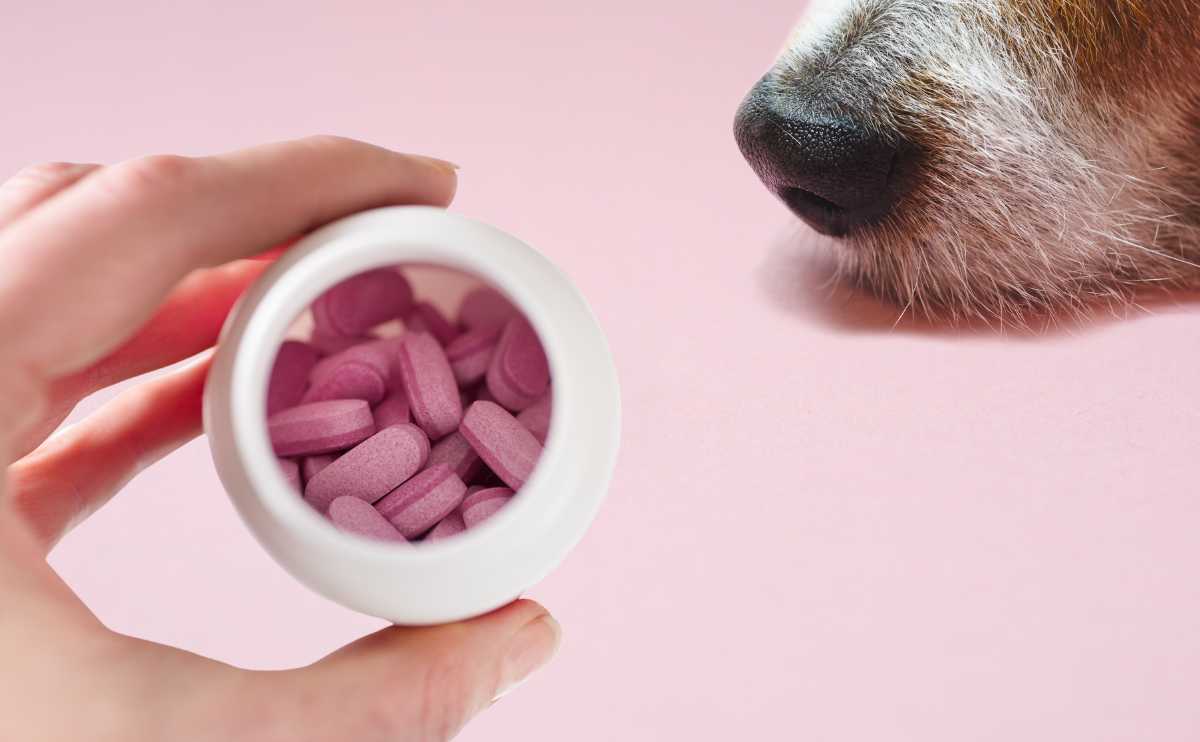
Benadryl (diphenhydramine HCI) is one of the very few human over-the-counter medications that are generally considered safe for dogs and that veterinarians often recommend. Many pup owners find this antihistamine helpful in relieving mild allergic reactions, mild itchy skin, and motion sickness in their canine counterparts. The widely accepted guideline is 1mg per pound of your dogs weight.
But before you share the Benadryl in your medicine cabinet with your dog, its important to know a few details to ensure your pups safety. Well tell you which forms of Benadryl are safe to administer to your pup, give you a handy dosage chart, and answer some other questions you may have about giving this OTC medication to your furry friend.
How Much Benadryl Can I Give My Dog?
While Benadryl is safe for most dogs, please remember that its so important to discuss giving it or any medication or supplement with your veterinarian. Your vet can make sure any non-prescribed product, like Benadryl, is safe for your dogs specific health conditions and will help give you dosing guidance.
With that said, the general dosing guide for Benadryl is pretty straightforward. Most vets and experts recommended a standard dose of roughly 1mg/pound. The standard Benadryl youll find in stores is 25mg/tablet for adult Benadryl. You can also use Childrens Liquid Benadryl, which is 12.5mg/5 ml. However, vets usually only recommend Childrens Liquid Benadryl for dogs under 10 pounds because its easier to achieve an accurate dose vs. tablets.
You can increase this dose a bit if needed, but be sure to get your vets okay. Benadryl is safe to give to dogs every eight to 12 hours (one to three times per day) in the short term. But for long-term use, its a good idea to consult your vet.
Benadryl For Dogs: Dosage By Weight
| Dogs Weight | Benadryl Dosage |
|---|---|
| 5 lbs | 5 mg 2 ml Childrens Benadryl |
| 10 lbs | 10 mg 4 ml Childrens Benadryl |
| 20 lbs | 20 mg 3/4 tablet |
| 30 lbs | 30mg- 1 tablet |
| 40 lbs | 40mg- 1.5 tablets |
| 50 lbs | 50mg- 2 tablets |
| 60 lbs | 60mg- 2.5 tablets |
| 70 lbs | 70mg- 2.5 tablets |
| 80 lbs | 80mg- 3 tablets |
| 90 lbs | 90-100mg- 3.5-4 tablets |
Did You Know?
When comparing Benadryl dosage levels for dogs to what adult humans can take, you may wonder why recommended doses for our canine counterparts are so high. Theres a simple reason for this. Dogs metabolize Benadryl and other antihistamines much faster than humans.
Childrens Liquid Benadryl For Dogs Dosage Chart
In general, vets usually recommend tablets for dogs over 10 pounds. However, if your dog loathes taking pills or you have trouble cutting up tablets, Childrens Liquid Benadryl is also safe for dogs of all sizes.
| Dogs Weight | Childrens Liquid Benadryl Dosage |
|---|---|
| 5 lbs | 2 ml |
| 10 lbs | 4 ml |
| 20 lbs | 8 ml |
| 30 lbs | 12 ml |
| 40 lbs | 16 ml |
| 50 lbs | 20 ml |
| 60 lbs | 24 ml |
| 70 lbs | 28 ml |
| 80 lbs | 32 ml |
| 90 lbs | 36 ml |
| 100 lbs | 40 ml |
Types Of Benadryl To Avoid Giving Your Dog
Diphenhydraminehydrochloride is the active ingredient in American Benadryl (found in the U.S., Canada, Singapore, Taiwan, Italy, and Hong Kong). However, in the U.K. and Denmark, the active ingredients areacrivastinein Benadryl Allergy Relief andcetirizinein Benadryl Once a Day. Limited information exists on acrivastine and cetirizine use in dogs, soif youre in Europe, make sure the active ingredient is diphenhydramine, the only form of Benadryl thats considered safe for dogs.
Regarding American Benadryl, you should avoid giving your pup the following forms:
- Liqui-Gels: Capsules are nearly impossible to break up to get the appropriate dose. Theyre also absorbed differently in dogs than in humans so this may cause issues with your pups dosage.
- Adult Liquid Benadryl: contains alcohol, which is toxic to dogs.
- Benadryl Allergy Plus Congestion:This Benadryl formula contains phenylephrine HCl, a common decongestant in human cold medications thats not safe for dogs.
- Extra Strength: While extra strength Benadryl is safe for dogs, it comes in 50 mg/tablet, and most vet dosing guidelines are for the 25 mg/tablet standard Benadryl. So, youll have to do your own calculations. To ensure your pups safety, its best to stick with vet guidelines.
Use Benadryl Cautiously With Some Dogs
Benadryl can make some conditions worse, so you should use caution if your pup suffers from any of the following health issues. Be sure to discuss Benadryl use with your veterinarian in these cases and if theres a possibility of adverse interactions with any other medication your furry friend is taking.
- Pregnancy or nursing
- Glaucoma
- Dry eye
- Heart disease
- High blood pressure
- Chronic obstructive pulmonary disease (COPD)
Our Personal Experience With Benadryl And Dogs
Several members of our team occasionally give our pups Benadryl under our veterinarians recommendations. Weve all found it to be safe and effective.

Lily got a hornet sting on her left back leg while on a walk. It swelled up quickly. When we got home, we immediately gave her Benadryl and monitored her symptoms closely for any changes. Additionally, we applied ice for 10 minutes once an hour. While she was still limping a few hours later, this treatment combo helped reduce some of the swelling and discomfort. Thankfully, within two days, Lily was feeling significantly better.
Michelle Schenker, co-founder of Canine Journal and pet parent of two rescue dogs
Frequently Asked Questions
How Often Can I Give My Dog Benadryl?
Typically, the effects of Benadryl last in your furry friends system for six to eight hours. But most vets and experts recommend giving your pup Benadryl every eight to 12 hours to account for differences in metabolism.
How Long Does It Take For Benadryl To Kick In For Dogs?
In most cases, it only takes about 1/2 hour to one hour for Benadryl to become effective for dogs. However, this time frame may vary depending on the dose you gave your pup as well as her age, weight, and health status.
Are There Side Effects & Overdosing Concerns With Benadryl Use In Dogs?
Most dogs tolerate Benadryl extremely well, and the risk of overdose is low. Side effects and overdosing are rare, but see our ultimate guide on Benadryl use in dogs to learn more about both of these concerns, as well as more detailed information about how Benadryl can help your pup.
Is Benadryl Effective For Dog Anxiety?
The sedative effects of Benadryl may help some dogs with situational anxiety, such as for fireworks, thunderstorms, or car rides. However, Benadryl can cause hyperactivity rather than sedation in some dogs. So many experts believe you have better options for anxiety relief for your furry friend. Alternatives to Benadryl include CBD oil, dog-specific calming supplements, or prescription medications for chronic anxiety.
Can I Use Childrens Chewable Tablets For My Dog?
Yes, Childrens Chewable Benadryl tablets are safe for dogs. Theyre ideal for smaller dogs. A full chewable childrens tablet contains 12.5 mg of diphenhydramine, so you can cut one in half for dogs weighing less than 10 pounds as an easy alternative to Childrens Liquid Benadryl.
Alternatives To Benadryl In Treating Chronic Allergy Symptoms
One of the most popular uses of Benadryl in dogs is to treat allergic reactions. This application can be extremely effective for temporary or short-term allergy symptoms, such as reactions to an insect bite or bee sting or mild seasonal allergies from pollen. However, Benadryl isnt your best line of defense if your pup suffers from long-term allergy problems.
If youve noticed that your pup is incessantly scratching her skin no matter what time of year, she could have a food intolerance or allergies to household environmental factors, such as dust mites or mold. For chronic allergic symptoms, which can include itchy, irritated skin and/or digestive issues, you may want to consider dog allergy supplements,daily medications, or monthly injections.
However, for chronic allergy symptoms, we recommend first consulting your veterinarian. Alternatively, you can give your pup anat-home dog allergy test kit. Thesekits test forintolerances to many food and environmental factors.Then, you can share these results with your vet to work on further diagnostics and a treatment plan.
Tagged With: Allergies, Medication
